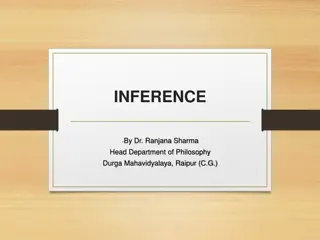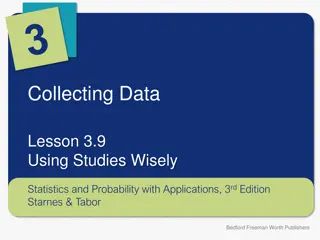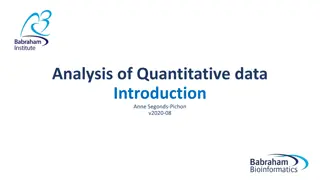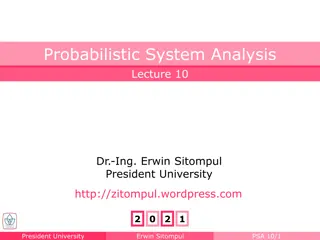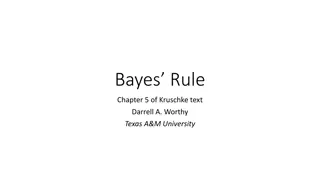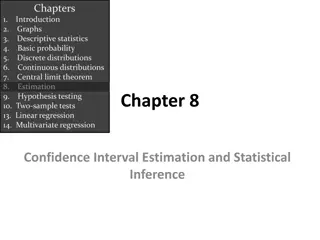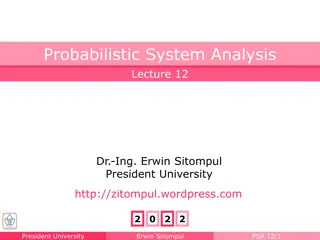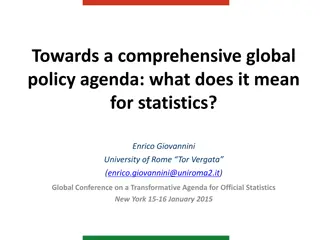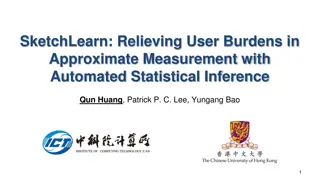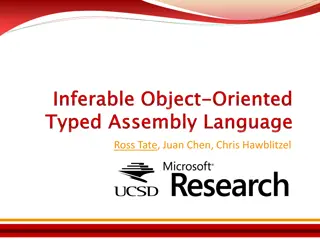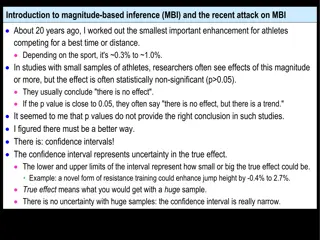Navigating Statistical Inference Challenges in Small Samples
In small samples, understanding the sampling distribution of estimators is crucial for valid inference, even when assumptions are violated. This involves careful consideration of normality assumptions, handling non-linear hypotheses, and computing standard errors for various statistics. As demonstrated through examples and theoretical scenarios, the complexities of statistical inference in small samples necessitate a nuanced approach to data analysis.
Download Presentation

Please find below an Image/Link to download the presentation.
The content on the website is provided AS IS for your information and personal use only. It may not be sold, licensed, or shared on other websites without obtaining consent from the author.If you encounter any issues during the download, it is possible that the publisher has removed the file from their server.
You are allowed to download the files provided on this website for personal or commercial use, subject to the condition that they are used lawfully. All files are the property of their respective owners.
The content on the website is provided AS IS for your information and personal use only. It may not be sold, licensed, or shared on other websites without obtaining consent from the author.
E N D
Presentation Transcript
"I was still a couple of miles above the clouds when it broke, and with such violence I fell to the ground that I found myself stunned, and in a hole nine fathoms under the grass, when I recovered, hardly knowing how to get out again. Looking down, I observed that I had on a pair of boots with exceptionally sturdy straps. Grasping them firmly, I pulled with all my might. Soon I had hoist myself to the top and stepped out on terra firma without further ado. (in Singular Travels, Campaigns and Adventures of Baron Munchausen, by R. E. Raspe,1786.) - Baron Munchausen
Introduction to Bootstrapping RIK CHAKRABORTI AND GAVIN ROBERTS
Sailing in the clouds Statistical Inference (hypothesis testing, or creating confidence intervals) requires knowledge about the sampling distribution of the estimator &/or the sampling distribution of test statistics. For example: To test H0: = 0 against HA: 0 b SE(b)~ t n k We use
Sailing in the clouds idealized assumptions and asymptotics But how do we get there? b Assume ~ N 0, 2I b ~ N( ,?2(X X) 1) SE(b)~ t n k But if errors are not normally distributed, and we don t have a sample size large enough to justify invoking the CLT, what is the sampling distribution of b SE(b) ?
The cloud breaks! If we don t know, should we assume normality? GAUSS EXAMPLE Shows empirical size of test is wrong when sample size is small under non-normal errors. Sampling distribution of the significance statistic does not follow the usual t(n k) distribution. If we still use t-table to test significance, we will make type I errors.
And we fall, hard! Previous example shows knowing the sampling distribution is important for valid inference. But, this may be difficult if 1. Assumptions about the distribution of errors are false. Errors may not be distributed normally, or even asymptotically normally. Computing sampling characteristics of certain statistics for finite sample sizes can be very difficult. Typically this is circumvented by resorting to asymptotic algebra. For example, for testing non-linear hypothesis when we use the delta method, we rely on asymptotic justification. 2.
Stuck in a rut, 9 fathoms deep? So, in small samples, how can we compute the standard errors of: 1 1 b, where is the true MPC? i. The estimated government expenditure multiplier ii. Elasticities such as: 7 ik r=1 Srjt rkxijtk where, xijt+ ijt) exp(?? xrjt+ rjt) exp(?? 7 Sijt= 1 + ?=1
So, what do we do? Basic problem have no clue about small sample properties of sampling distribution of estimator/statistic of interest. SOLUTION GO MONTE CARLO?
Monte Carlo, with a difference! Typically, we ve run Monte-Carlo simulations in the context of simple regressions. STEPS: 1. Simulate sample data using process that mimics true DGP. 2. Compute statistic of interest for sample. 3. Repeat for mind bogglingly large number of times as long as it doesn t boggle the computer s mind - Generates sampling distribution of statistic of interest
Monte Carlo, with a difference! Implementing in our case - ??= ? + ???+ ?? 1. Start off with initial sample: ?1 ?2 . . ?? ?1 ?2 . . ?? ???
Monte Carlo, with a difference (steps 2 and 3) Run OLS, obtain estimates ? and ?. Then, generate new samples using these estimates: ?1 ?2 . . ?? ?1 ?2 . . ?? 1 1 . . 1 ? ? . . ? = ? + ? +
Heres the difference Since assumption of normality is suspect here, we instead rely on the sample to create an artificial distribution of errors to draw from. Create artificial vector of errors by drawing uniformly from residual vector with replacement ?1 ?2 . . ?? ?1 ?2 . . ??
Procedure So, generate new sample as: ?1 ?2 . . ?? ?1 ?2 . . ?? ?1 ?2 . . ?? 1 1 . . 1 = ? + ? + Compute b , repeat B times - generates estimated sampling distribution of b.
Why does it work? Consistency of b consistency of e as estimator of Bootstrapped point estimate: 1 B r=1 B bB= br 1 B(br bB)(br bB) B 1 r=1 var bB = d It can be shown that bBb
But We assumed the errors were exchangeable equally likely to occur with every observation. What if larger error variances are associated with larger ?values (heteroskedasticity)? In such cases we can do the Paired Bootstrap : Take (?? ??) pairs as initial sample and resample with replacement to create new samples.
Advantages of the paired bootstrap Keeps error paired with original explanatory variable it was associated with. Implicitly employs true errors, true underlying parameters and preserves original functional form. Allows explanatory variables to vary across samples assumption of non-stochastic regressors relaxed.
Common uses Estimation of standard errors when these are hard to compute Figuring out proper size of tests, i.e., type I error rates. Bias correction.
Caution check sturdiness of straps before the haul! Bootstrapping performs better in estimating sampling distributions of asymptotically pivotal statistics statistics whose sampling distribution does not depend on unknown population parameters. sampling distribution of parameter estimates typically depend on population parameters. Instead, bootstrapped sampling distribution of the t-statistic converges faster.
Further references for prospective bootstrappers 1. Kennedy Chapter 4, section 6, if you want to understand the bootstrap 2. Cameron and Trivedi Chapter 11, if you want to do the bootstrap 3. MacKinnon (2006) Uses and abuses to be wary of. 4. And most importantly, Watch The adventures of Baron Munchausen the awesome Terry Gilliam movie.




